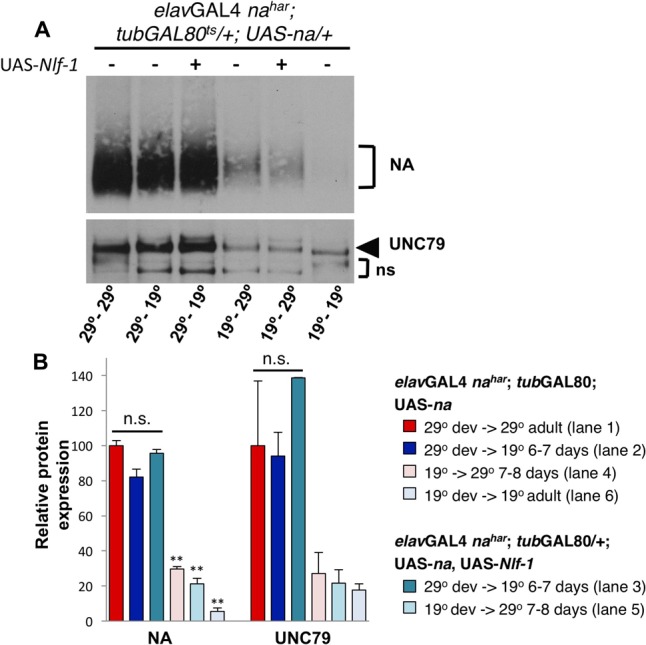FIGURE 7.

Developmental expression of UAS-na yields higher levels of channel complex proteins than adult-restricted expression. Western blot analyses of NA and UNC79 expression from head extracts in Drosophila males raised at 19°C or 29°C and maintained at 19°C or 29°C as adults, as indicated. (A) Representative Western blot data. All flies are elavGAL4 nahar; tubGAL80ts/ +; UAS-na/+, and some strains include co-expression of UAS-Nlf-1 (lanes 3,5) (Flourakis et al., 2015). Developmental (dev) and adult temperature conditions are indicated below each lane (dev temperature – adult temperature). Adult flies shifted from 19 to 29°C (lanes 4–5) were maintained at 29°C for 7–8 days prior to protein extraction, while flies shifted from 29 to 19°C (lanes 2–3) were maintained at 19°C for 6–7 days before extraction. (B) Quantitation of NA and UNC79 levels for genotypes and conditions shown in panel (A; see key). Bars indicate normalized protein levels, as a percentage of levels observed in elavGAL4 nahar; tubGAL80ts/ +; UAS-na/+ flies in the 29°C development- 29°C adult condition (red bars; part A, lane 1). Error bars indicate standard error of the mean, as determined from two independent experiments. For elavGAL4 nahar; tubGAL80ts/ +; UAS-na/+ shifted from 29 to 19°C, with or without UAS-Nlf-1 (dark blue and dark teal bars; part A, lanes 2–3), protein levels are not significantly different from the 29°C to 29°C control (p > 0.08). For elavGAL4 nahar; tubGAL80ts/ +; UAS-na/+ shifted from 19 to 29°C in adulthood, with or without UAS-Nlf-1 (dark blue and dark teal bars; part A, lanes 2–3), NA protein levels are significantly different from the 29°C to 29°C control (∗∗p < 0.01). UNC79 protein levels in the 19°C to 29°C shifted conditions are < 30% of 29°C to 29°C control, but this difference does not reach significance. Statistical comparisons were made using Student’s t-test.
